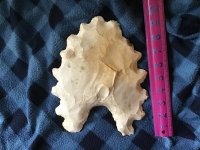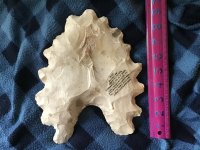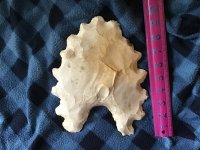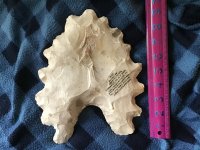Navigation
Install the app
How to install the app on iOS
Follow along with the video below to see how to install our site as a web app on your home screen.
Note: This feature may not be available in some browsers.
More options
You are using an out of date browser. It may not display this or other websites correctly.
You should upgrade or use an alternative browser.
You should upgrade or use an alternative browser.
Aztec Artifacts in the US ?
- Thread starter Samanthy
- Start date
- Jul 27, 2006
- 49,439
- 57,694
- Detector(s) used
- Minelab_Equinox_ 800 Minelab_CTX-3030 Minelab_Excal_1000 Minelab_Sovereign_GT Minelab_Safari Minelab_ETrac Whites_Beach_Hunter_ID Fisher_1235_X
- Primary Interest:
- All Treasure Hunting
Samantha, please keep all political and religious comments out of all forums except our politics forum. Thanks.
DaveVanP
Sr. Member
- Oct 5, 2018
- 375
- 682
- Detector(s) used
- Minelab XTerra 705
Fisher F44
- Primary Interest:
- Prospecting
If you study Cahokia in IL you will come to the conclusion that they were Aztecs that came from Mexico. Many of the artifacts from Cahokia look identical to Aztec artifacts. Google "Cahokia arrow point", then google "Aztec arrow point". They are the same. Cahokia was laid out as a city before it was built. It wasn't a small village that got larger. If featured a "wood henge", similar to Stone Hedge, which was their calendar. Also the huge mound they built. For whatever reason, a large group split from Mexico and came north around 600 AD. I don't see archaeologists pushing this idea, but I believe it's true. Gary
That would put the migration *about* the time of the collapse of the Mayan civilization...
metrotec
Sr. Member
- Jan 5, 2020
- 418
- 703
- Detector(s) used
- Whites, Radio Shack, Metrotec, peach tree fork
- Primary Interest:
- All Treasure Hunting
like i've posted before, there is a stone temple in N Georgia. National forest, guarded by the state, but a Cherokee native can and will show you the site. Also the mound builders near Cartersville, GA. mounds with steps that look like stone mounds, but dirt. These guys were 7 feet tall, black hair to their waist.
High school history books have gotten wrong since they were written, so have the PHD's.
High school history books have gotten wrong since they were written, so have the PHD's.
uniface
Silver Member
A lot of similarities, but Cahokia is about 300 years older than the Aztec culture. If one came from the other, it was Cahokia snow birds headed south for the winter.
Or, in conjecture, Cahokia could have been founded by Aztec immigrants who left Mexico previous to their own culture reaching its peak. Possibly over some fundamental disagreement that make separating preferable to conflict.
Granted, that's not a very likely supposition. But it wouldn't be the first time in history such a scenerio played out either -- here in the US with William Penn, the Pilgrims et. al. -- all arriving here well before England reached its apex.
metrotec
Sr. Member
- Jan 5, 2020
- 418
- 703
- Detector(s) used
- Whites, Radio Shack, Metrotec, peach tree fork
- Primary Interest:
- All Treasure Hunting
the stone mounds in Georgia date back bc 3000 go figure..some archaeologist dispute, because of their own agenda. see Edgar Cayce, stone mounds Georgia, He gave a reading on the stones in 1933 ad.
Charl
Silver Member
Apparently, the residents of Cahokia came from many places....
Sacrificial and Common Graves Alike Reveal Diversity in Ancient City of Cahokia ? Western Digs
Whether they died from natural causes or as sacrificial offerings, the residents of America’s largest prehistoric city were surprisingly diverse, with at least a third of the population having come from communities up to hundreds of kilometers away, according to new research of the settlement’s ancient graves.
Known to archaeologists as Cahokia, the city once stood near modern-day St. Louis, in a swath of Mississippi River floodplain known as American Bottom. At its peak 900 years ago, it was the metropole of a sprawling civilization whose social, economic, and religious influence reached from the Great Lakes to the Gulf of Mexico.....
......”Researchers have long debated about the source of Cahokia’s large estimated population, with some arguing for a coalescence of already-present localized communities, and others arguing for an influx of ‘new’ people from far-away regions such as the Gulf Coast or Great Lakes area.”
While some experts have theorized that Cahokia could only have built up its massive population with a steady flow of immigrants, Slater added, “direct empirical evidence – beyond some similarities of material culture to surrounding regions – to support this hypothesis was not available until now.”
The evidence Slater’s team turned to was human teeth – found in graves throughout Greater Cahokia, from commonplace burials of people who died naturally, to some of the more unusual mass graves from a burial mound known as Mound 72.
By analyzing these teeth, the researchers were able to glean where people buried throughout the city had been born, grown up, and spent their adult lives.
Slater’s team accomplished this using a method known as strontium isotope analysis. The element strontium occurs naturally in soil, as well as plant and animal tissue, with different variations, or isotopes, showing up in ratios that are unique to every region, shaped by the chemistry of the local landscape.
When people eat plants — or animals that ate plants — that region’s signature levels of strontium become stored in their teeth and bones.
What’s more, because different teeth form at different ages, scientists can use them to effectively map a person’s whereabouts through much of his or her early life.
Teeth that form in infancy, for example, like the first permanent molars, will reveal a person’s location as a newborn, while those that form in the early teens, like the third molars, will bear the chemical traces of their home in adolescence. [See how this technique was used to study another unusual burial: “Mass Grave of ‘Prodigal Sons’ in California Poses Prehistoric Mystery“]
Armed with this technique, Slater’s team studied 133 teeth from 87 people, found in 13 different burial contexts throughout American Bottom.
The results showed that 38 of the teeth, about 29 percent, had strontium ratios that were outside the local range, indicating that those people had been born and raised elsewhere and migrated to Cahokia as adults.
“The most significant implication of our findings is that Cahokia’s population was derived from multiple locations within and outside the American Bottom,” Slater said.
Sacrificial and Common Graves Alike Reveal Diversity in Ancient City of Cahokia ? Western Digs
Whether they died from natural causes or as sacrificial offerings, the residents of America’s largest prehistoric city were surprisingly diverse, with at least a third of the population having come from communities up to hundreds of kilometers away, according to new research of the settlement’s ancient graves.
Known to archaeologists as Cahokia, the city once stood near modern-day St. Louis, in a swath of Mississippi River floodplain known as American Bottom. At its peak 900 years ago, it was the metropole of a sprawling civilization whose social, economic, and religious influence reached from the Great Lakes to the Gulf of Mexico.....
......”Researchers have long debated about the source of Cahokia’s large estimated population, with some arguing for a coalescence of already-present localized communities, and others arguing for an influx of ‘new’ people from far-away regions such as the Gulf Coast or Great Lakes area.”
While some experts have theorized that Cahokia could only have built up its massive population with a steady flow of immigrants, Slater added, “direct empirical evidence – beyond some similarities of material culture to surrounding regions – to support this hypothesis was not available until now.”
The evidence Slater’s team turned to was human teeth – found in graves throughout Greater Cahokia, from commonplace burials of people who died naturally, to some of the more unusual mass graves from a burial mound known as Mound 72.
By analyzing these teeth, the researchers were able to glean where people buried throughout the city had been born, grown up, and spent their adult lives.
Slater’s team accomplished this using a method known as strontium isotope analysis. The element strontium occurs naturally in soil, as well as plant and animal tissue, with different variations, or isotopes, showing up in ratios that are unique to every region, shaped by the chemistry of the local landscape.
When people eat plants — or animals that ate plants — that region’s signature levels of strontium become stored in their teeth and bones.
What’s more, because different teeth form at different ages, scientists can use them to effectively map a person’s whereabouts through much of his or her early life.
Teeth that form in infancy, for example, like the first permanent molars, will reveal a person’s location as a newborn, while those that form in the early teens, like the third molars, will bear the chemical traces of their home in adolescence. [See how this technique was used to study another unusual burial: “Mass Grave of ‘Prodigal Sons’ in California Poses Prehistoric Mystery“]
Armed with this technique, Slater’s team studied 133 teeth from 87 people, found in 13 different burial contexts throughout American Bottom.
The results showed that 38 of the teeth, about 29 percent, had strontium ratios that were outside the local range, indicating that those people had been born and raised elsewhere and migrated to Cahokia as adults.
“The most significant implication of our findings is that Cahokia’s population was derived from multiple locations within and outside the American Bottom,” Slater said.
Last edited:
DaveVanP
Sr. Member
- Oct 5, 2018
- 375
- 682
- Detector(s) used
- Minelab XTerra 705
Fisher F44
- Primary Interest:
- Prospecting
That would put the migration *about* the time of the collapse of the Mayan civilization...
The Maya civilization declined around 900 AD, but the city of Teotihuacan was abandoned around 500-600 AD...
The fall of Teotihuacan left a void to be filled by the later Aztec/Mexica Empire (about 950 AD), which thrived for nearly 600 years, when the Spanish showed up.
- Nov 24, 2006
- 16,486
- 25,169
- Detector(s) used
- Nokta Simplex, Land Ranger Pro, Quick Draw Pro, Deteknix XPointer
- Primary Interest:
- Metal Detecting
I lived in Cartersville for a year back in '67. My friends dad was the manager of the Etowah Indian Mounds. A small museum in a trailer at the time, but don't remember a temple. But yes, big dirt steps. There is also weird lights that show up from time to time over them. My fried said it was swamp gas, but I never saw a swamp.like i've posted before, there is a stone temple in N Georgia. National forest, guarded by the state, but a Cherokee native can and will show you the site. Also the mound builders near Cartersville, GA. mounds with steps that look like stone mounds, but dirt. These guys were 7 feet tall, black hair to their waist.
High school history books have gotten wrong since they were written, so have the PHD's.
metrotec
Sr. Member
- Jan 5, 2020
- 418
- 703
- Detector(s) used
- Whites, Radio Shack, Metrotec, peach tree fork
- Primary Interest:
- All Treasure Hunting
Drink more wine; a good conversation never started over a salad.
- Jan 27, 2009
- 18,792
- 11,909
- 🥇 Banner finds
- 1
- Detector(s) used
- Tesoro Conquistador freq shift
Fisher F75
Garrett AT-Pro
Garet carrot
Neodymium magnets
5' Probe
- Primary Interest:
- All Treasure Hunting
Maize.
Charl
Silver Member
uniface
Silver Member
Complete crap.
https://exploringrealhistory.blogspo...to-earths.html
Huge mound complexes were built here millenia before agriculture appeared.
https://exploringrealhistory.blogspo...to-earths.html
Huge mound complexes were built here millenia before agriculture appeared.
Charl
Silver Member
Complete crap.
https://exploringrealhistory.blogspo...to-earths.html
Huge mound complexes were built here millenia before agriculture appeared.
Just because mounds existed prior to widespread agriculture does not mean maize was not related to the rise of Cahokia. Also, “complete crap” is not really the most cogent argument.
MAMucker
Bronze Member
Interesting read.
Side thought...Maize. I wonder why anyone (to explain no early evidence in the Northeast) would jump to the conclusion that corn had to adapt to a shorter growing season in order to grow in the northeast? Planting to harvest is 90 days -no matter where it’s planted.
Statements like these speculations become settled science very quickly and broad brushed into the record and eco chamber.
MAMucker
Bronze Member
Complete crap.
https://exploringrealhistory.blogspo...to-earths.html
Huge mound complexes were built here millenia before agriculture appeared.
Also an interesting read
H.P.
Hero Member
H.P.
Hero Member
BillA
Bronze Member
google it indeed, what you are showing is not a Mayan yoke, neither in form or function
edit: someone more knowledgeable than I can comment on what you have
the peanut gallery here says modern
edit: someone more knowledgeable than I can comment on what you have
the peanut gallery here says modern
Last edited:
Madmox
Hero Member
- Mar 26, 2014
- 643
- 995
300 years seems like a very short amount of time.
The Native Americans of Northern California believed that they all came from the north.
With groups splitting off along the way. Some continued south.
I would bet there were some words common to all of the various tribal languages.
That’s because they are of Athabaskan descent. The Athabaskans were from Canada and steadily migrated south slaughtering anyone they found in their way, apparently it was quite the genocide and they steamrolled south. They were one of the primary reasons the Muggilion (sp), Nez Pierce, and Anisazi were wiped out and probably why they ended up as cliff dwellers in the Southwest. At least this was as it was outlined during the Native American studies class in College I was conscripted into taking. I will say, coming from an area with a heavy native influence the professor got a lot of students wound up dropping those little truth bombs. It kept it entertaining, watching people that had this idea that the native peoples were peaceful melt down and start arguing.
Madmox
Hero Member
- Mar 26, 2014
- 643
- 995
I think everyone is confusing Aztec with other South/Central American groups. Aztecs and Mayans are always referred to due to their familiarity, but neither was the largest nor the longest-lived group.
If mass migration is the underlying theory of the populating of North America, first across the Bering Strait and then southward and eastward, what would stop a group from leaving South/Central America for undiscovered parts of what is now the U.S.? I would venture to guess that this happened frequently, and undoubtedly semblances of their culture would have accompanied them, because this was all they knew at the time. Either establishing new settlements or assimilating into existing settlements would probably also yield some sort of evidence, just as the Spanish influence was evident here (although theirs was done more by force and eradication).
Further, the physical landscape has changed tremendously over the past 10,000 years, and while there are some historical records depicting the actions of some Central American groups, what was undoubtedly lost will always be the missing link. For example, the coastline of the Gulf of Mexico, particularly in the Big Bend area (Apalachicola to Cedar Key), was 100 miles seaward. Recently, a 7,000 year old Archaic burial site was discovered off the coast, and I have personally witnessed tree stumps located in 40 feet of water, nearly 15 miles south of Dog Island, Florida. To theorize that there is a large number of undiscovered sites that are currently underwater is not a stretch.
As far as mound and effigy similarities, Cahokia is a great example, and so is the Letchworth Mound in Jefferson County, Florida.
Archaeologists may speculate, but few have been outspoken about the connection between the cultures of South/Central America and North America. Much of their research is built from previous assumptions or theories, and when those are challenged, the old guard comes out of the woodwork to defend their turf rather than admit they may have been wrong. The newer generation of archaeologists seem to have a more open mindset, so maybe we'll see some new studies emerge.
This is a depiction of the large mound at Letchworth, and to the layperson it resembles the architecture of South/Central America:
View attachment 1726608
I know that here in the Pacific NW they do quite a bit of archaeology underwater on Native villages that have been inundated along the coast as sea levels have risen and fallen over the millennia.
Top Member Reactions
-
 3358
3358 -
 1989
1989 -
 1932
1932 -
 1164
1164 -
 1096
1096 -
 890
890 -
 806
806 -
 797
797 -
 794
794 -
 788
788 -
 751
751 -
 537
537 -
 484
484 -
 460
460 -
 444
444 -
 425
425 -
 422
422 -
 420
420 -
E
409
-
 383
383
Users who are viewing this thread
Total: 3 (members: 0, guests: 3)











